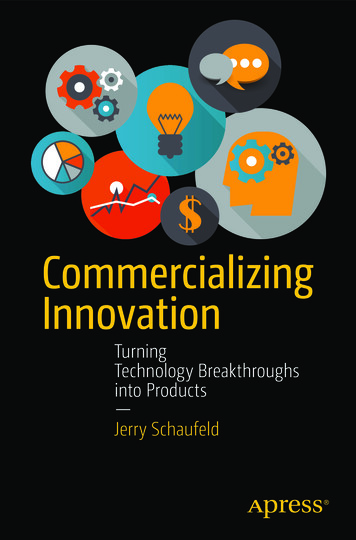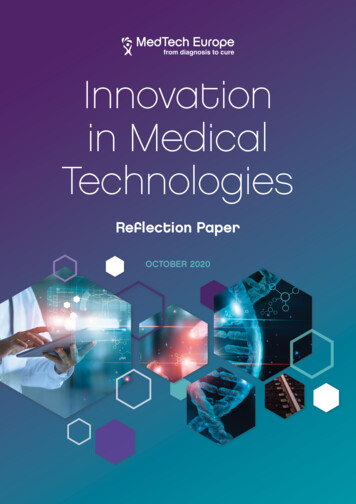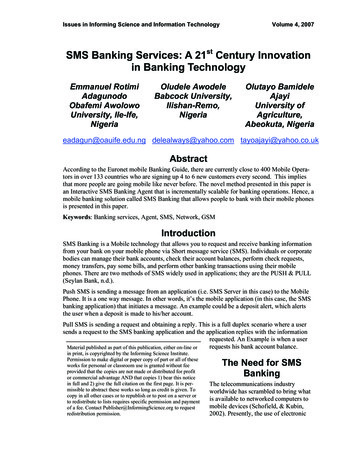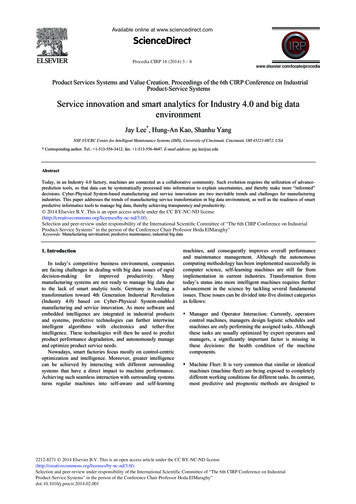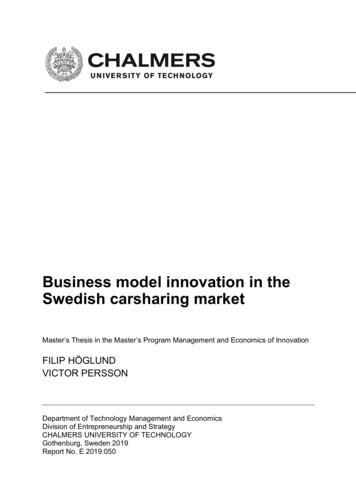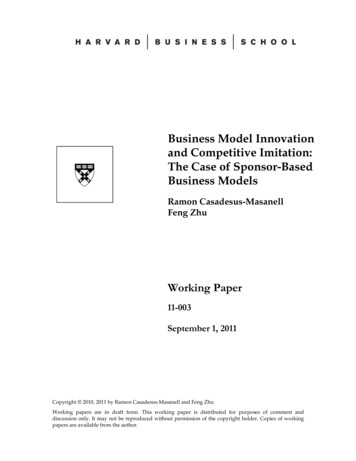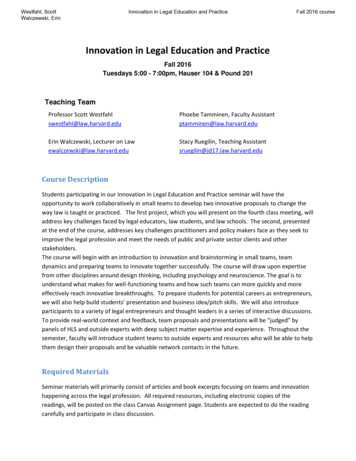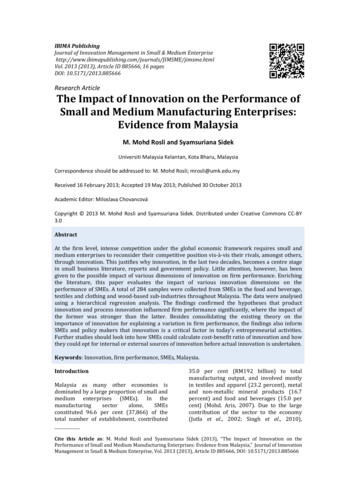
Transcription
IBIMA PublishingJournal of Innovation Management in Small & Medium JIMSME/jimsme.htmlVol. 2013 (2013), Article ID 885666, 16 pagesDOI: 10.5171/2013.885666Research ArticleThe Impact of Innovation on the Performance ofSmall and Medium Manufacturing Enterprises:Evidence from MalaysiaM. Mohd Rosli and Syamsuriana SidekUniversiti Malaysia Kelantan, Kota Bharu, MalaysiaCorrespondence should be addressed to: M. Mohd Rosli; mrosli@umk.edu.myReceived 16 February 2013; Accepted 19 May 2013; Published 30 October 2013Academic Editor: Miloslava ChovancováCopyright 2013 M. Mohd Rosli and Syamsuriana Sidek. Distributed under Creative Commons CC-BY3.0AbstractAt the firm level, intense competition under the global economic framework requires small andmedium enterprises to reconsider their competitive position vis-à-vis their rivals, amongst others,through innovation. This justifies why innovation, in the last two decades, becomes a centre stagein small business literature, reports and government policy. Little attention, however, has beengiven to the possible impact of various dimensions of innovation on firm performance. Enrichingthe literature, this paper evaluates the impact of various innovation dimensions on theperformance of SMEs. A total of 284 samples were collected from SMEs in the food and beverage,textiles and clothing and wood-based sub-industries throughout Malaysia. The data were analysedusing a hierarchical regression analysis. The findings confirmed the hypotheses that productinnovation and process innovation influenced firm performance significantly, where the impact ofthe former was stronger than the latter. Besides consolidating the existing theory on theimportance of innovation for explaining a variation in firm performance, the findings also informSMEs and policy makers that innovation is a critical factor in today’s entrepreneurial activities.Further studies should look into how SMEs could calculate cost-benefit ratio of innovation and howthey could opt for internal or external sources of innovation before actual innovation is undertaken.Keywords: Innovation, firm performance, SMEs, Malaysia.IntroductionMalaysia as many other economies isdominated by a large proportion of small andmedium enterprises (SMEs). In themanufacturingsectoralone,SMEsconstituted 96.6 per cent (37,866) of thetotal number of establishment, contributed35.0 per cent (RM192 billion) to totalmanufacturing output, and involved mostlyin textiles and apparel (23.2 percent), metaland non-metallic mineral products (16.7percent) and food and beverages (15.0 percent) (Mohd. Aris, 2007). Due to the largecontribution of the sector to the economy(Jutla et al., 2002; Singh et al., 2010),Cite this Article as: M. Mohd Rosli and Syamsuriana Sidek (2013), “The Impact of Innovation on thePerformance of Small and Medium Manufacturing Enterprises: Evidence from Malaysia,” Journal of InnovationManagement in Small & Medium Enterprise, Vol. 2013 (2013), Article ID 885666, DOI: 10.5171/2013.885666
Journal of Innovation Management in Small & Medium Enterprisecompetitiveness and development of SMEsmust be sustained over time. Intensecompetition under the global economicframework requires SMEs to reconsider theircompetitive position vis-à-vis their local andforeign rivals. Porter (1980) reminded thatcompetitive strategies differentiating aparticular firm from its competitors woulddetermine its survival in business. To D’Cruzand Rugman (1992), a firm would be morecompetitive if it is able to design, produce,and market products or services superior tothose offered by its rivals. All these marketchanges and needs reveal why it is almostimpossible to find any industrial player, whorefuses to innovate (Hurley and Hult, 1998).This also reminds the firms that innovation isno more a luxury, but a necessity (Kaplan andWaren, 2007).Due to the growing importance of innovationto human beings in general andentrepreneurship in particular, manyempirical studies were conducted to examinethe relationship between this strategic factorand firm performance (for examples,Guimaraes and Langley, 1994; Lin and Chen,2007; Trienekens et al., 2008; Bakar andAhmad, 2010; Peng et al., 2011; Chong et al.,2011). However, the previous studiesinclined to focus on one or two dimensions ofinnovation, such as product innovation(Alegre et al., 2006; Espallardo and Ballester,2009; Zhang and Duan, 2010; Bakar andAhmad, 2010), product and processinnovation (Georgellis et al., 2000; Ar andBaki, 2011; Prajogo et al., 2007; Medina andRufin, 2009) and market innovation (Johne,1999). For the sake of knowledgedevelopment, this paper evaluates the impactof various dimensions of innovation on theperformance of SMEs. The findings in thispaper would be useful for theoreticaldiscussion as well as for policy formulationand entrepreneurial development.2Literature ReviewInnovationThe early concept of innovation in economicdevelopment and entrepreneurship waspopularized by Joseph Schumpeter, a Germaneconomist. Innovation, in his view, comprisesthe elements of creativity, research anddevelopment (R&D), new processes, newproducts or services and advance intechnologies (Lumpkin and Dess, 2001). ToKuratko and Hodgetts (2004), innovation isthe creation of new wealth or the alterationand enhancement of existing resources tocreate new wealth. Innovation is also seen asa process of idea creation, a development ofan invention and ultimately the introductionof a new product, process or service to themarket (Thornhill, 2006). At present, thisconcept is applied in every facet of sociallives and activities. This makes theinnovationconceptbecomemoremultidimensional and intricate.Beaver (2002) believes that innovation is anessential element for economic progress of acountry and competitiveness of an industry.Innovation plays an important role not onlyfor large firms, but also for SMEs (Jong andVermeulen, 2006; Anderson, 2009). Sandvik(2003) argues that innovation is one of themost important competitive weapons andgenerally seen as a firm’s core valuecapability. Innovation is also considered asan effective way to improve firm’sproductivity due to the resource constraintissue facing a firm (Lumpkin and Dess, 1996).Bakar and Ahmad (2010) add that thecapability in product and businessinnovation is crucial for a firm to exploit newopportunities and to gain competitiveadvantage.M. Mohd Rosli and Syamsuriana Sidek (2013), Journal of Innovation Management in Small & Medium Enterprise,DOI: 10.5171/2013.885666
3Journal of Innovation Management in Small & Medium EnterpriseFirm PerformanceOutsiders normally evaluate a firm’s abilitybased on its performance (Bonn, 2000). Thisimplies why performance is like a mirror to afirm. The level of goal accomplishmentgenerally defines a firm’s performance(Achrol and Etzel, 2003). Firm performanceis the outcomes achieved in meeting internaland external goals of a firm (Lin et al., 2008).Asamultidimensionalconstruct,performance has several names, includinggrowth (Dobbs and Hamilton, 2006; Wolffand Pett, 2006), survival, success andcompetitiveness. The concept of firm growthwas introduced in the early 1930s known asthe “Law of Proportionate Effect” (sometimescalled Gibrat's rule of proportionate growth).The Law of Proportionate Effect is frequentlyused as a benchmark for many studies todetermine business growth. Gibrat’s (1931)explains a firm’s growth rate does notdepend on the size of a firm.Traditionally, a variation in firm performanceis associated with industrial structure(Frazier and Howell, 1983). The neo-classicaleconomic theory perceives a firm’s growth asa process of attaining the minimum point ofaverage cost. In other words, the process of afirm’s growth is similar to the process ofprofit optimisation (Trau, 1996). In 1959,Penrose developed a resource-based-viewtheory (Garnsey, 1988), where a firm’sperformance is dependent upon theresources and capabilities it has as a sourceof sustainable competitive advantages in themarket (Wernerfelt, 1984; Peteraf, 1993;Mahoney, 1995). Garnsey (1988) argues thatfirms must access, mobilize and deployresources before they can grow. Adoption ofvarious strategies by firms also determinesfirm performance. Different firm usesdifferent strategies of performance (Collinsand Porras, 2000); hence, a firm’sperformance is concentrated in its strategy(Short et al., 2007).Depending on organizational goals, differentmethods are adopted by different firms tomeasuretheirperformance.Thisperformance indicator can be measured infinancial and non-financial terms (Darroch,2005; Bagorogoza and Waal, 2010; Bakar andAhmad, 2010). Most firms, however, prefer toadopt financial indicators to measure theirperformance (Grant et al., 1988; Hoskinson,1990). Return on assets (ROA) (Zahra, 2008),average annual occupancy rate, net profitafter tax and return on investment (ROI)(Tavitiyaman et al., 2012) are the commonlyused financial or accounting indicators byfirms. Some other common measures areprofitability,productivity,growth,stakeholder satisfaction, market share andcompetitive position (Garrigos-Simon andMarques, 2004; Marques et al., 2005;Bagorogoza and Waal, 2010). However,financial elements are not the only indicatorfor measuring firm performance. It needs tocombine with non-financial measurement inorder to adapt to the changes of internal andexternal environments (Krager and Parnell,1996). Supporting this opinion, Rubio andAragon (2009) divided business performanceinto four dimensions, that is internal process,open system, rational goal and humanrelations, where each dimension is measuredby any changes in its own variables.Innovation and Firm PerformanceThe importance of innovation is described byRoberts and Amit (2003) as a means leadingto a competitive advantage and superiorprofitability. As revealed in many studies,innovation and firm performance have apositive relationship (for examples Zahra andDas, 1993; Capon et al., 1990; Calantone et al.,1995; Han et al., 1998). Innovation wouldappear in product, process, market, factorand organisation (Kao, 1989), but the firstthree dimensions are more familiar in theinnovation literature (see Johne and Davies,2000; Otero-Neira et al., 2009).Product InnovationProduct innovation can be defined as thecreation of a new product from newmaterials (totally new product) or thealteration of existing products to meetM. Mohd Rosli and Syamsuriana Sidek (2013), Journal of Innovation Management in Small & Medium Enterprise,DOI: 10.5171/2013.885666
Journal of Innovation Management in Small & Medium Enterprisecustomer satisfaction (improved version ofexisting products) (Gopalakrishnan andDamanpour, 1997; Langley et al., 2005). Italso refers to the introduction of newproducts or services in order to create newmarkets or customers, or satisfy currentmarkets or customers (Wang and Ahmed,2004; Wan et al., 2005). Myers and Marquis(1969) contend that product innovation canbe made by exploiting new ideas. Productinnovation provides a variety of choice forproducts (Craig and Hart, 1992).Product innovation is one of the importantsources of competitive advantage to the firm(Camison and Lopez, 2010). With innovation,quality of products could be enhanced, whichin turn it contributes to firm performanceand ultimately to a firm’s competitiveadvantage (Garvin, 1987; Forker et al. 1996).According to Hult et al. (2004), productinnovation offers a potential protection to afirm from market threats and competitors.Bayus et al. (2003) proved that productinnovation had positive and significant linkwith organizational performance. Using atotal number of 744 Spanish-firm samples,Espallardo and Ballester (2009) confirmed apositive impact of innovation on firmperformance. Similarly, Alegre et al. (2006)found that both product innovationdimensions (efficacy and efficiency) werestrongly and positively related to firmperformance. The introduction of novelproduct is positively associated with firmperformance was also confirmed by Varisand Littunen (2010). Therefore, the firsthypothesis is stated as:4commercial activities (Freeman, 1982). ToOke et al. (2007), process innovationconcerns with the creation of orimprovement in techniques and thedevelopment in process or system. Forinstance, innovation in technology, skill,techniques, system and procedure, which isused in the process of transforming inputinto output (Zhuang et al., 1999). In aproduction activity, process innovation canbe referred to as new or improvedtechniques, tools, devices, and knowledge inmaking a product (Gopalakrishnan andDamanpour, 1997; Langley et al., 2005; Wanet al., 2005; Oke et al., 2007).Crucial to the manufacturing industry,process innovation should be emphasized bya firm as its primary distinctive competencefor competitive advantage (Nemetz and Fry,1988). More specifically, such an innovationis positively associated with firm growth(Morone and Testa, 2008). Consistent withthis argument, Varis and Littunen’s (2010)study on SMEs in Finland found that processinnovation is positively related with firmperformance. Using new technology as aproxy for process innovation, Anderson(2009) found a significant relationshipbetween new technology and firmperformance. Recent evidence by Ar and Baki(2011) reconfirmed the positive andsignificant influence of product and processinnovation on firm performance. As such,Hypothesis 2:Process innovation ispositively associated with firm performance.Market InnovationHypothesis 1:Product innovation ispositively associated with firm performance.Process InnovationIn general, process innovation is the processof reengineering and improving internaloperation of business process (Cumming,1998). This process involves many aspects ofa firm’s functions, including technical design,R&D, manufacturing, management andAccording to Johne (1999), marketinnovation deals with the market mix andmarket selection in order to meet acustomer’s buying preference. Continualmarket innovation needs to be done by a firmbecause state-of-the-art marketing tools,particularly through the Internet, make itpossible for other competitors to reachpotential customers across the globe at alight speed. Rodriguez-Cano et al. (2004)M. Mohd Rosli and Syamsuriana Sidek (2013), Journal of Innovation Management in Small & Medium Enterprise,DOI: 10.5171/2013.885666
5Journal of Innovation Management in Small & Medium Enterpriseassert that market innovation plays a crucialrole in fulfilling market needs andresponding to market opportunities. In thisrespect, any market innovation has to bedirected at meeting customers’ demand andsatisfaction (Appiah-Adu and Satyendra,1998).The importance of market innovation to firmperformance, albeit limited, is discussed inthe literature, too. Sandvik (2003) discoveredthat market innovation has a positive effecton sales growth of a firm. To Johne andDavies (2000), market innovation wouldaugment sales through the increasingdemand for products, which in turn yieldsadditional profit to innovative firms.Similarly, Otero-Neira et al. (2009) foundstrong evidence that market innovationpositively influenced business performance.Adding to this finding, Varis and Littunen(2010) using an estimated model confirmeda highly significant relationship between amarket-related innovative activity and firmperformance. This leads to the followinghypothesis:Hypothesis 3:Market innovation ispositively associated with firm performance.Research MethodsData SourcePrimary data used in this study werecollected from SMEs in the food and beverage,textiles and clothing, and wood-based subindustries. A strict rule was applied forcollecting the data, amongst others, theselected firms must be: SMEs (with notmore than 150 full-time employees); inoperation for at least three years; and runby the owner or manager. A pilot surveywas done with the help of a predeterminedquestionnaire. It was conducted in the sameindustries on 20 non-sample key informants(the owner or manager of the firms), whohad sufficient knowledge and experience inthe issues under investigation. This exercisewas carried out to check time duration takinga respondent to complete the questionnaireand to validate items used for each construct.This strategy would reduce response biasand measurement error (Kumar et al. 1993)in the sample.Upon satisfactory with the responses on thefield and preliminary reliability tests (withCronbach’s alpha of more than 0.70 for eachconstruct under the study), an actual surveyusing a self-administered questionnaire wascarried out by the researchers with theassistance of six trained enumerators. Thequestionnaire was completed by therespondents in 15-20 minutes time. In thecase where the respondents were extremelybusy entertaining their customers during thefirst visit, the questionnaire had been left forseveral days before it was collected in thenext visit.A total of 284 SMEs all over the country(except Sarawak) participated in the study.Some characteristics of the samplerespondents and SMEs are shown in Table 1.It shows that a majority of the respondentswere male (58.8 per cent). The highest levelof education for most of the respondents wassecondary school. However, about 24 percent of the respondents had tertiaryeducation, indicating that entrepreneurshipturned out to be an increasing choice amongMalaysians. With respect to legal registrationof the business, a majority of the businesswas sole proprietorship and private limited.In terms of sample distribution by subindustry, 42.3 per cent were from food andbeverage, 32.4 per cent from textile andclothing and 25.3 per cent from wood-based.M. Mohd Rosli and Syamsuriana Sidek (2013), Journal of Innovation Management in Small & Medium Enterprise,DOI: 10.5171/2013.885666
Journal of Innovation Management in Small & Medium Enterprise6Table 1: Some Characteristics of the ingPrimary schoolSecondary schoolTertiary educationOthersLegal RegistrationSole ProprietorshipPartnershipPrivate LimitedOthersIndustryFood and BeverageTextile and urce: Based on the sample survey.MeasuresIndependent VariablesInnovation as an independent variable in thisstudy was divided into product innovation,process innovation and market innovation.Product innovation included three items,namely the introduction of new product,technological newness in product, andproduct differentiation. Process innovationcomprised three items, that is R&Dorientation, the application of newtechnology and new combination ofmaterials in production. Market innovationconsisted of three items, i.e. the application ofonline transaction, innovative marketing andpromotion, and the ability to find newmarkets. All these items were adapted fromOtero-Neira et al. (2009), and Lan and Wu(2010).The respondents were asked, “In the lastthree years, to what extent has your firmemphasised each item of innovation”. Theirresponses were based on a given 7-pointscale, ranging from ‘1 hardly emphasised’ to‘7 strongly emphasised’. The degree of theiremphasis on innovation was then averagedby calculating the mean score across thenumber of items for each innovationdimension (see Segev, 1987). Prior to thisprocess, exploratory factor analysis withVarimax rotation had been used to identifythe latent independent constructs, i.e. thethreeinnovationdimensions.Onecomponent was found to be extracted fromeach construct identification process. A quickcheck on reliability of each innovationdimension produced Cronbach’s (1951)Alpha of more than 0.70, indicating thereliability of the instrument for further use. Aone-way analysis of variance (ANOVA) wasrun to test if there was any difference ininnovation dimensions across the three subindustries (ρ 0.05). The results showed nosignificant differences in all innovationdimensions between the sub-industries.Therefore, the analysis of innovation by subindustries was ignored. In other words, totalsample and not sub-samples was adopted inthis study.M. Mohd Rosli and Syamsuriana Sidek (2013), Journal of Innovation Management in Small & Medium Enterprise,DOI: 10.5171/2013.885666
7Journal of Innovation Management in Small & Medium EnterpriseDependent VariablesIn the absence of objective ce by the respondents themselvesis more relevant (Love et al., 2002).Performance indicators in this study werereturns on sale, returns on asset, profitability,market share, sales revenue, labourproductivity and employment. Thesemultidimensional performance measures arerelevant,especiallywhenobjectiveperformance measures are unreachable (see,Kellermanns et al., 2010). For each item, therespondents were asked to compare theirgrowthperformanceagainsttheircompetitors in the same industry for the lastthree years on a 7-point scale ranging from“1 very low” to “7 very high”. Suchassessment method is regarded reliablebenchmarks (Delaney and Huselid, 1996)and taken care of for possible influence of theindustry factor. This overall performancemeasure was summed up and then averagedto obtain a performance index for meaningfulinterpretation. The Varimax Rotation methodand the reliability test revealed high loadingsof the seven items (0.61 to 0.86) on theoverallperformanceconstructwithCronbach’s alpha of 0.93, meaning that theitems were the strong representative of theperformance construct.Control VariablesSome control variables which commonlyappear in the business performanceliterature were included in the model. Theywere the level of owner’s education (Nichterand Goldmark, 2009; Fairlie and Robb, 2007;Mengistae,2006),owner’sbusinessexperience (Mengistae, 2006; Alowaihan,2004), firm age (Birley and Westhead, 1990)and firm size (Ozgulbas et al., 2006); Orser, etal., 2000). Owner’s education, owner’sbusiness experience, and firm age weremeasured by the number of years ofeducation,experienceandbusinessoperation, respectively. Firm size wasmeasured by the number of full-timeemployees.Results and DiscussionAs shown in Table 2, the respondents, onaverage, had 12-year education (mean,12.05), but longer business experience (mean,13.96 years). Most of the firms were in theindustry for more than ten years (mean age,12.82), but their size was rather small (meanfirm size, 11.70). More unfortunately, theemphasis of the SMEs on innovation wasrather moderate. The mid-rank value of thisstudy was 4. Judging from the mean values ofproduct innovation (mean, 4.74), processinnovation (mean 3.95) and marketinnovation (mean, 4.44); the SMEs gave moreemphasis on product innovation and less onthe other two dimensions of innovation.Probably due to moderate level of innovation,the overall performance of the SMEs (mean,4.19) was moderate, too.The correlation statistics in Table 2 showthattheassociationbetweentheindependent variables is low to modest,indicating the absence of multicollinearityproblems and thus allowing for a regressionanalysis. The multicollinearity problemswere also cross-checked with the Toleranceand VIF. The tolerance values of theindependent variables ranged between 0.594and 0.984, which are not less than 0.10. Inthe meantime, the VIF values of theindependent variables ranged between 1.016and 3.147, which are well below the cut-off10. All this suggests that the multicollinearityassumption is not violated and the regressionresults are not distorted by this problem (seePallant, 2007).M. Mohd Rosli and Syamsuriana Sidek (2013), Journal of Innovation Management in Small & Medium Enterprise,DOI: 10.5171/2013.885666
Journal of Innovation Management in Small & Medium Enterprise8Table 2: Mean, Standard Deviation and Correlations of the VariablesVariables1. Education (years)2. Business experience (years)3. Firm age (years)4. Firm size (employees)5. Product Innovation6. Process Innovation7. Market Innovation8. Overall firm 20.020.120.62**0.51**0.45**0.60**0.45**0.38**** Correlation is significant at the 0.01 level.* Correlation is significant at the 0.05 level.Source: Based on the sample survey.The hierarchical regression analysis wasapplied to estimate the impact of innovationon firm performance. As displayed in Table 3,four models were estimated in order to seehow much changes would occur when oneparticular variable after another included inthe empirical model. Separating the modelestimations would help us to see thecontribution of each factor more clearlythrough the improvement of the explanatorypower of the model (the R-square). The Rsquare change (ΔR2) improved significantlyin Model 2 and Model 3, when productinnovation and process innovation wereincluded into the models, indicating theimportance of these two innovationdimensions to firm performance. In contrast,the inclusion of market innovation in Model 4did not improve the R-square significantly incomparison with Model 3. This indicates thatmarket innovation does not contribute muchto the variation in firm performance.Since Model 4 estimated all the variablesunder the study, this model is given dueattention. Results in Model 4 show that firmsize was the only control variable influencingfirm performance positively and significantly(β 0.005, p 0.01). This finding is sensiblesince larger firms are better able to: employmore competent employees, obtain moreefficient production facilities (Sandesara,1966), exploit economies of scale andeconomies of scope, and formaliseprocedures; where all this makes theiroperations more efficient, leading to theirsuperior performance relative to smallerfirms (Penrose, 1959).Quite the opposite, the other three controlvariables - education, business experienceand firm age - did not significantly affect firmperformance. Alowaihan (2004) argues thathigh education does not guarantee anentrepreneur to have technical and businessmanagement skills; thus, education hadinsignificant impact on firm performance.Dyke and Fisher (1992) reminded that thetypes and sources of business experiencewould determine the strength and directionof the relationship between this factor andfirm performance. It will be significantlypositive if the experience gained by anentrepreneur is similar and suited to thepresent business. In contrast, there will be nosignificant relationship between the twoconstructs if the experience acquired isdissimilar and unsuited to the presentbusiness. This may also be the case when theexperience does not enhance the existingcompetencyandexpertiseofanentrepreneur related to the need of presentbusiness (Reuber et al. 1990). With regardsto firm age, more than half (52.0 per cent) ofthe firms in this study were rather new (upto ten years old), which may explain why thevariation in this factor did not significantlychange firm performance. This justification isconsistent with another study on SpanishSMEs (Moreno dan Casillas, 2007).M. Mohd Rosli and Syamsuriana Sidek (2013), Journal of Innovation Management in Small & Medium Enterprise,DOI: 10.5171/2013.885666
9Journal of Innovation Management in Small & Medium EnterpriseTable 3: Results of the Hierarchical Regression AnalysisIndependent Variables1. Education (years)2. Business experience (years)3. Firm age (years)4. Firm size (no. of employees)5. Product Innovation6. Process Innovation7. Market InnovationConstantR2Adjusted 3.047***0.2570.2380.00813.301***Note:Dependent variable, SME’s overall performance.* p 0.05, ** p 0.01, and *** p 0.001 are significant at the 0.05, 0.01 and 0.001 level respectively.Source: Based on the sample survey.In line with Hypothesis 1 and Hypothesis 2,product innovation and process innovationimpacted firm performance positively andsignificantly with β 0.123 (p 0.01) and β 0.111(p 0.01) respectively. Interestingly,the relatively stronger impact of productinnovation compared to process innovationon firm performance is in agreement with astudy elsewhere (Ar and Baki, 2011). Incontrast, the impact of market innovation onfirm performance was not significant and notsupportive of Hypothesis 3. A questionremains here why the increased marketinnovation among innovative firms was nottranslated into superior firm l factors may dilute the impactof market innovation on firm performance(Gatignon and Xuereb, 1997; Carbonell andRodriguez, 2006). This means that marketinnovation does not guarantee the innovativefirms to reap benefit from their innovativeactions, when there are rapid changes inbusiness environment they operate. Theadoption of e-commerce and e-marketing, forexample, would give little impact on a firm’sperformance in the market, when the otherfirms (particularly larger firms) behavesimilarly.Theoretically, the findings in this paperconsolidate the existing belief thatinnovation in product and process impactfirm performance positively and significantly.Empirically, this suggests that SMEs inMalaysia, particularly in the food andbeverage, textiles and clothing and woodbased sub-industries would also benefit fromsuch innovation. Practically, the findingsremind SMEs and policy makers about theimportance of innovation in product andprocess to a firm. Despite the moderate levelof innovation among the sampled SMEs, itempirically proved that such innovationcontributed superior performance to thosewho were more innovative.The globalisation process has indeed forcedmany firms to be competitive in the globalmarketpl
Feb 16, 2013 · in small business literature, reports and government policy. Little attention, however, has been given to the possible impact of various dimensions of innovation on firm performance. Enriching the literature, this paper evaluates the impact of
